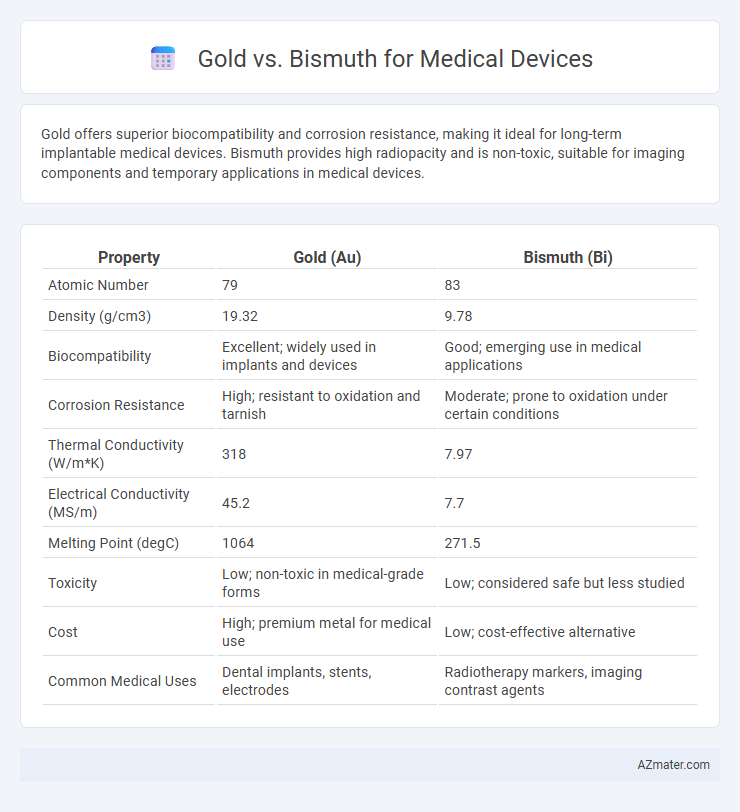Gold offers superior biocompatibility and corrosion resistance, making it ideal for long-term implantable medical devices. Bismuth provides high radiopacity and is non-toxic, suitable for imaging components and temporary applications in medical devices.
Table of Comparison
| Property | Gold (Au) | Bismuth (Bi) |
|---|---|---|
| Atomic Number | 79 | 83 |
| Density (g/cm3) | 19.32 | 9.78 |
| Biocompatibility | Excellent; widely used in implants and devices | Good; emerging use in medical applications |
| Corrosion Resistance | High; resistant to oxidation and tarnish | Moderate; prone to oxidation under certain conditions |
| Thermal Conductivity (W/m*K) | 318 | 7.97 |
| Electrical Conductivity (MS/m) | 45.2 | 7.7 |
| Melting Point (degC) | 1064 | 271.5 |
| Toxicity | Low; non-toxic in medical-grade forms | Low; considered safe but less studied |
| Cost | High; premium metal for medical use | Low; cost-effective alternative |
| Common Medical Uses | Dental implants, stents, electrodes | Radiotherapy markers, imaging contrast agents |
Introduction to Gold and Bismuth in Medical Devices
Gold is widely used in medical devices due to its exceptional biocompatibility, corrosion resistance, and excellent electrical conductivity, making it ideal for applications such as implants, sensors, and diagnostic equipment. Bismuth is gaining attention for medical devices due to its low toxicity, high density, and radiopacity, which are valuable properties in X-ray shielding and contrast agents. Both metals offer unique advantages, with gold favored for long-term implant stability and bismuth preferred for cost-effective radiological applications.
Material Properties: Gold vs Bismuth
Gold exhibits exceptional biocompatibility, high electrical conductivity, and excellent corrosion resistance, making it ideal for implantable medical devices and sensors. Bismuth, with its low toxicity, high density, and significant X-ray attenuation properties, is preferred for radiation shielding and imaging applications in medical devices. While gold offers superior mechanical ductility and stability, bismuth's lower melting point and environmental friendliness provide advantages in specific device manufacturing processes.
Biocompatibility and Safety Comparison
Gold exhibits excellent biocompatibility due to its inertness, resistance to corrosion, and minimal cytotoxicity, making it a preferred material for long-term implantable medical devices. Bismuth, while offering unique radiopacity and antimicrobial properties, generally shows lower biocompatibility compared to gold, with potential toxicity concerns depending on its chemical form and exposure levels. Safety profiles favor gold for critical applications due to its stable nature and established medical use history, whereas bismuth requires careful formulation to mitigate biocompatibility risks in devices.
Imaging Applications: Gold vs Bismuth
Gold nanoparticles exhibit superior biocompatibility and enhanced X-ray attenuation properties, making them highly effective contrast agents in medical imaging applications such as CT scans. Bismuth nanoparticles offer higher atomic number benefits, providing stronger X-ray absorption and improved image contrast, particularly valuable in radiography and tomography. The choice between gold and bismuth hinges on balancing toxicity, contrast efficiency, and cost, with gold favored for biocompatibility and bismuth for cost-effective high-contrast imaging.
Cost Analysis and Availability
Gold offers superior biocompatibility and corrosion resistance essential for medical devices but comes at a significantly higher cost, with market prices approximately $60 per gram compared to bismuth's $0.02 per gram. Bismuth, while less costly and more abundant, lacks the same long-term stability but remains a viable option for disposable or low-cost medical components. Considering global supply chains, gold's stable availability from established mining regions contrasts with bismuth's limited production, primarily as a byproduct of lead and copper mining, potentially affecting consistent supply for high-volume manufacturing.
Radiopacity and Contrast Enhancement
Gold exhibits superior radiopacity compared to bismuth, making it more effective for enhancing visibility in medical imaging. Its high atomic number (79) ensures stronger X-ray attenuation, which significantly improves contrast enhancement in diagnostic procedures. Bismuth, with a lower atomic number (83), provides moderate radiopacity but generates less distinct contrast, limiting its efficacy in detailed imaging of medical devices.
Antimicrobial Properties in Medical Devices
Gold exhibits excellent antimicrobial properties due to its ability to disrupt bacterial cell membranes and inhibit biofilm formation, making it a valuable material for coating medical devices. Bismuth also demonstrates significant antimicrobial activity, particularly against antibiotic-resistant strains, through its ability to release ions that interfere with microbial metabolism. Comparing both, gold offers superior durability and biocompatibility, while bismuth provides cost-effective antimicrobial efficacy, influencing their selection for specific medical device applications.
Manufacturing and Processing Considerations
Gold offers excellent biocompatibility and corrosion resistance, making it ideal for medical devices but requires high-temperature processing and complex electroplating techniques that increase manufacturing costs. Bismuth, with its non-toxic properties and low melting point, enables easier casting and machining, reducing energy consumption and production time in device fabrication. Both materials demand precision in processing to maintain structural integrity and functionality, but gold's superior conductivity and stability often justify its premium in critical medical applications.
Clinical Case Studies and Current Usage
Gold exhibits outstanding biocompatibility and corrosion resistance, making it a preferred material for implantable medical devices such as stents and pacemakers, with numerous clinical case studies validating its long-term stability and low immunogenicity. Bismuth is increasingly explored for radiopaque markers and antimicrobial coatings due to its non-toxic profile and enhanced imaging contrast, supported by emerging clinical trials demonstrating improved device visibility and infection control. Current usage trends highlight gold's dominance in cardiovascular implants while bismuth gains traction in diagnostic tools and wound care devices.
Future Trends: Gold and Bismuth in Medical Innovation
Gold's exceptional biocompatibility and conductive properties make it an enduring choice for implantable medical devices, while bismuth's emerging role leverages its radiopacity and low toxicity for advanced imaging and targeted drug delivery systems. Future trends indicate a growing integration of nanostructured gold and bismuth composites that enhance sensor sensitivity and therapeutic precision in wearable and implantable technologies. Innovations in combining gold's stability with bismuth's unique physical properties are driving breakthroughs in minimally invasive diagnostics and personalized medicine.

Infographic: Gold vs Bismuth for Medical Device
 azmater.com
azmater.com